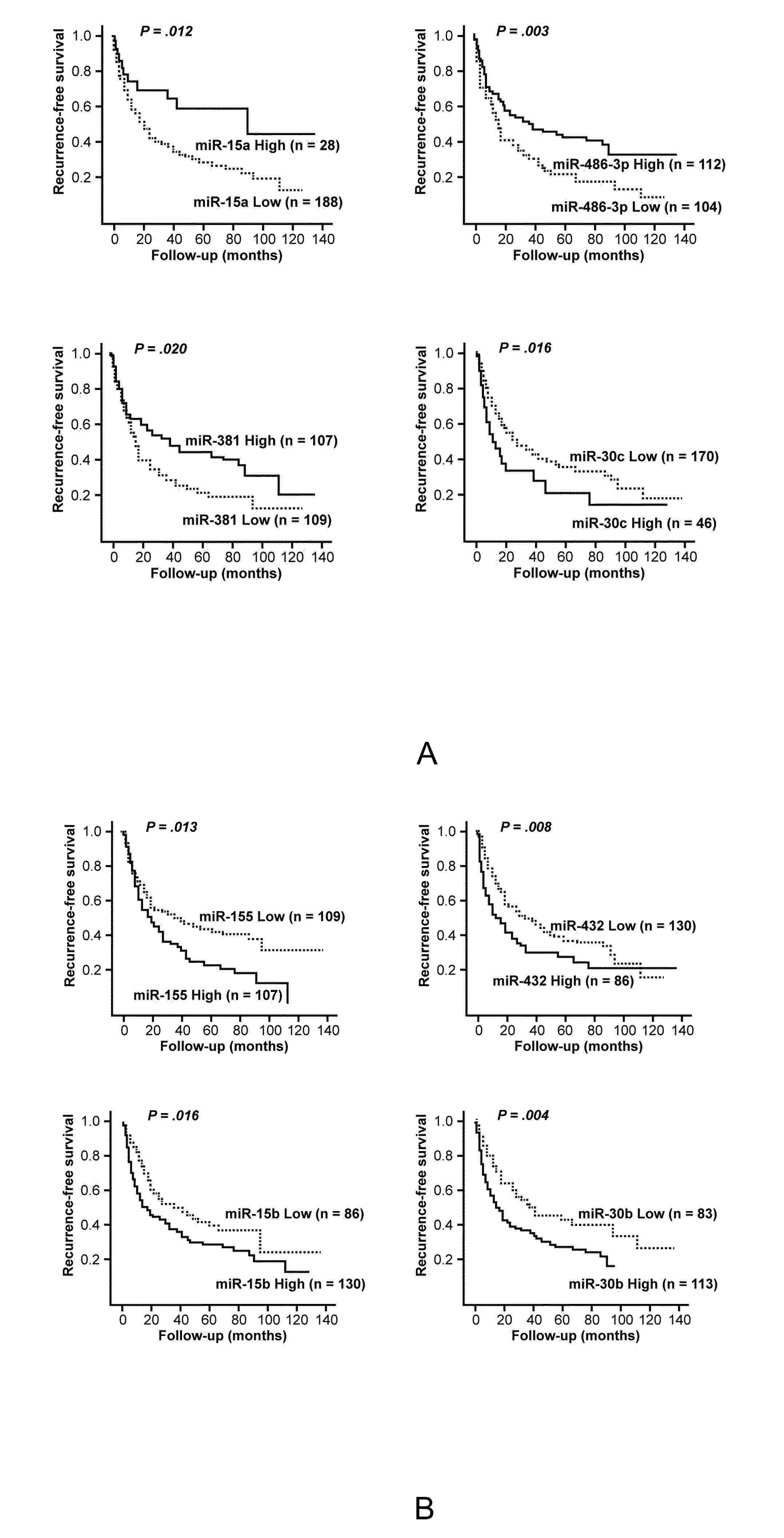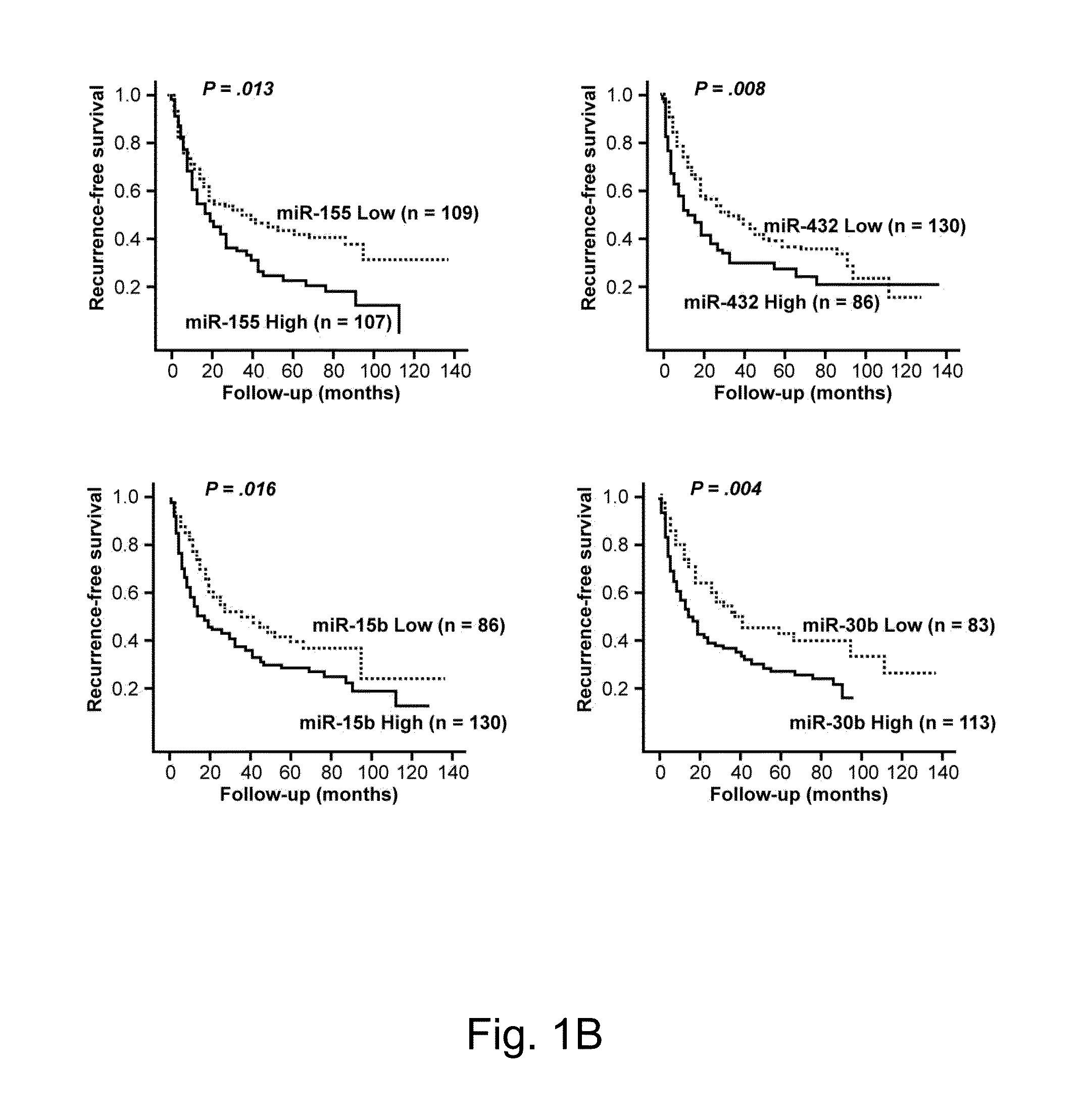MicroRNA-Based Methods for Prognosis of Hepatocellular Carcinoma
a technology of hepatocellular carcinoma and microrna, applied in the field of molecular biology, to achieve the effect of reducing the probability of unfavorable prognosis and a favorable prognosis
- Summary
- Abstract
- Description
- Claims
- Application Information
AI Technical Summary
Benefits of technology
Problems solved by technology
Method used
Image
Examples
example 1
Expression Profiles of miRNA in the Non-Cancerous Liver Tissues in Patients with Known Clinical Outcomes
[0080]In the pilot stage, expression profiles of miRNA in the non-cancerous liver tissues from HCC patients with known better (n=6) and poorer (n=6) clinical outcomes were analyzed to identify potential prognostic miRNA markers. Twenty miRNA markers with the lowest P values in two statistical tests were included as candidate markers. The P values ranged from 0.010 to 0.055 using Mann-Whitney test and from 0.004 to 0.454 using Cox proportional hazard analysis.
example 2
Identification of miRNA Associated with Postoperative Survivals in HCC Patients
[0081]In the verification stage, the non-cancerous liver tissues from 216 HCC patients were used to verify the prognostic predictive value of the 20 microRNA candidates. Univariate and multivariate analysis was performed to examine the association between expression levels of the 20 microRNAs and the RFS and OS, respectively, and the results were summarized in Table 5. For univariate and multivariate Cox regressions, the measures of effect are hazard ratio (HR) and adjusted hazard ratio (adjusted HR), respectively. A hazard ratio (or adjusted HR) of 1 means no effect for the high-expression group over the low-expression group. A hazard ratio (or adjusted HR) of 1.5 means that the high-expression group has 1.5 times more hazard of the low-expression group. The higher the hazard ratio (or adjusted HR) the lower is the survival probability for the high-expression group, and vice versa.
TABLE 5Univariate and m...
example 3
Clinicopathological Factors and microRNA Associated with Postoperative Survivals in HCC
[0086]The Cox proportional hazard model was performed to analyze whether some of the instantly claimed microRNAs (miR-155, miR-15a, miR-432, miR-486-3p, miR-15b and miR-30b) were independent factors when clinicopathological variables were included, and the results were summarized in Table 6.
TABLE 6Univariate and Multivariate Analysis of Clinicopathological andmicroRNA Parameters for Recurrence-Free Survival in HCC PatientsPatientMean RFSHRAdjusted HRNo.(months)(95% CI)(95% CI)ParameterAge (years)≦6012552.9 (39.4-61.1)>609144.8 (34.9-54.6)0.925(0.638-1.341) GenderFemale4659.3 (41.4-77.3)Male17048.9 (37.1-56.2)1.377(0.873-2.171) CirrhosisNo9956.7 (43.1-70.3)Yes11741.4 (33.5-51.8)1.241(0.862-1.786) AlcoholismNo15450.9 (40.8-61.0)Yes6246.9 (33.0-60.8)1.115(0.758-1.640) MicrovascularNo13557.3 (46.2-68.4)invasionYes8132.5 (23.3-41.6)1.7651.178(1.223-2.544)*(0.787-1.765)Edmondson'sI-II6950.9 (35.6-66.2)g...
PUM
| Property | Measurement | Unit |
|---|---|---|
| length | aaaaa | aaaaa |
Abstract
Description
Claims
Application Information
 Login to View More
Login to View More - R&D
- Intellectual Property
- Life Sciences
- Materials
- Tech Scout
- Unparalleled Data Quality
- Higher Quality Content
- 60% Fewer Hallucinations
Browse by: Latest US Patents, China's latest patents, Technical Efficacy Thesaurus, Application Domain, Technology Topic, Popular Technical Reports.
© 2025 PatSnap. All rights reserved.Legal|Privacy policy|Modern Slavery Act Transparency Statement|Sitemap|About US| Contact US: help@patsnap.com



